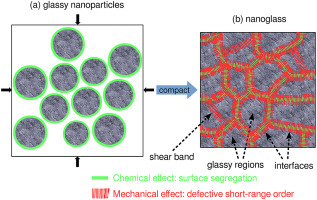当前位置:
X-MOL 学术
›
Acta Mater.
›
论文详情
Our official English website, www.x-mol.net, welcomes your feedback! (Note: you will need to create a separate account there.)
Microstructure formation of metallic nanoglasses: Insights from molecular dynamics simulations
Acta Materialia ( IF 9.4 ) Pub Date : 2018-02-01 , DOI: 10.1016/j.actamat.2017.12.014 Omar Adjaoud , Karsten Albe
Acta Materialia ( IF 9.4 ) Pub Date : 2018-02-01 , DOI: 10.1016/j.actamat.2017.12.014 Omar Adjaoud , Karsten Albe

|
Abstract We investigate the microstructure formation of Pd80Si20 and Cu64Zr36 nanoglasses by molecular dynamics simulations of the consolidation process of nanometer-sized metallic glassy spheres. Our results reveal that during cold compaction most of the glassy spheres deform by homogeneous plastic flow and in some glassy spheres strain localization occurs in a shear band which traverses the whole glassy sphere. Moreover, the porosity is closed if hydrostatic pressures exceed 4 GPa. The resulting nanoglasses are composed of glassy regions connected by glass-glass interfaces. The results reveal that the width of these interfaces is significantly larger than estimated in previous atomistic models based on planar interfaces. Moreover, structural changes occur not only in the interfaces but also in the glassy regions. In addition, thermodynamics analysis show that surface segregation is favorable in the primary glassy spheres but not always in the nanoglass. The present findings shed light on the process of the microstructure formation of metallic nanoglasses and can serve to interpret the experimental results.
中文翻译:

金属纳米玻璃的微观结构形成:分子动力学模拟的见解
摘要 我们通过纳米金属玻璃球固结过程的分子动力学模拟研究了 Pd80Si20 和 Cu64Zr36 纳米玻璃的微观结构形成。我们的结果表明,在冷压实过程中,大多数玻璃球体通过均匀塑性流动变形,并且在一些玻璃球体中,应变局部化发生在穿过整个玻璃球体的剪切带中。此外,如果静水压力超过 4 GPa,孔隙将关闭。由此产生的纳米玻璃由玻璃-玻璃界面连接的玻璃区域组成。结果表明,这些界面的宽度明显大于之前基于平面界面的原子模型估计的宽度。此外,结构变化不仅发生在界面上,而且发生在玻璃区域。此外,热力学分析表明,在初级玻璃球中表面偏析是有利的,但在纳米玻璃中并不总是如此。本研究结果阐明了金属纳米玻璃的微结构形成过程,并可用于解释实验结果。
更新日期:2018-02-01
中文翻译:

金属纳米玻璃的微观结构形成:分子动力学模拟的见解
摘要 我们通过纳米金属玻璃球固结过程的分子动力学模拟研究了 Pd80Si20 和 Cu64Zr36 纳米玻璃的微观结构形成。我们的结果表明,在冷压实过程中,大多数玻璃球体通过均匀塑性流动变形,并且在一些玻璃球体中,应变局部化发生在穿过整个玻璃球体的剪切带中。此外,如果静水压力超过 4 GPa,孔隙将关闭。由此产生的纳米玻璃由玻璃-玻璃界面连接的玻璃区域组成。结果表明,这些界面的宽度明显大于之前基于平面界面的原子模型估计的宽度。此外,结构变化不仅发生在界面上,而且发生在玻璃区域。此外,热力学分析表明,在初级玻璃球中表面偏析是有利的,但在纳米玻璃中并不总是如此。本研究结果阐明了金属纳米玻璃的微结构形成过程,并可用于解释实验结果。



























 京公网安备 11010802027423号
京公网安备 11010802027423号